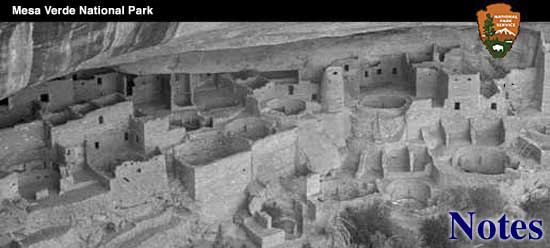

|
The Pentstemons are members of the Figwort Family (Scrophulariaceae). This is one of the largest and most widely distributed of families containing about 205 genera and 2600 species. Two genera of the family — "Castilleja," Indian Faint Brush, and Pentstemon or "Beard Tongue" are among the most attractive midsummer flowers on the Mesa Verde. Ten different varieties of Pentstemons have so far been identified in the park flora. They are the most gorgeous of a our numerous herbaceous flowers. The corolla is two-lipped with a swollen tube, the upper lip is usually two-lobed and lower cleft into three. There are five stamens and it is from this that the flower gets its genus name. The word Pentstemon comes from the Greek, pent meaning five. This name is often mispronounced as the accent should be on the second syllable. The stamens are arranged in two pairs and a fifth sterile filament, and often they are covered by fine woolly hairs. The whole flower resembles an open mouth within which reposes a hairy tongue, hence its common name "Beard-Tongue."
The varieties that may be found on the Mesa, and listed somewhat according to height of growth are as follows: 1. Pentstemon suffrutescens — Rydb. Light blue in color, and can be recognized by the lower woody branches that have a tendency to send out roots where they touch the ground. Small smooth leaves. The whole rarely reaches over 12 inches. Seems to prefer a heavy soil among the Junipers and Pinons. Elevation 6900 feet. 2. Pentstemon coloradoensis — Nels. Light blue tinged with lilac, often mistaken for suffrutescens. Grows more erect, lower parts glaborous, not so woody. Leaves slightly larger, flowers more prominent and larger. Similar habitat to the above species. 3. Pentstemon bridgesii — Grey Bright red. Flower stalks usually containing one to five flowers, leaves are lance like, the larger ones rarely exceeding 2-1/2 inches. Grow erect very little bunching, stems reaching about 20 inches. Prefer to grow among rocks. 4. Pentstemon acuminatus — Dougl. Color pink to purple. Flowers are showy and about 3/4 inch long and funnel like in shape. The sterile filament is flattened out and has a yellow beard. Leaves are broader than in the foregoing species and of about the same length. Grows about 24 inches high and prefers a barren sandy soil. 5. Pentstemon comarrhenus — Grey. Purplish blue flowers, each about one inch long and very narrow. Basal leaves are oval and upper ones are linear. Slender stems that are glaucos or powdery, reach a height of 24 inches. Found among the Junipers and Pinons. 6. Pentstemon glaber — Pursh. Color, blue or purple. The sterile filament is enlarged at the bearded summit. Lower leaves are narrowed to petioles, while the upper ones are broadened and spear shaped. Plant is branched, usually three or more flower stalks come up from the base. Grows to a height of 24 inches. Prefers a moist soil. 7. Pentstemon trichander — (Grey) Rydb. Scarlet red flowers are rather short, the anthers have long woolly hairs. Stems usually purplish in color arise from a woody base. Upper leaves long and slender, lower ones tend to be more oblong. Lives among the sage and cedars in the canyons often reaching a height of 40 inches. 8. Pentstemon strictus — Benth. Dark blue in color of flowers which have a rather narrow throat and widely spreading lips. They are arranged on a many flowered stalk. Anthers have few hairs and the sterile filament usually slender and naked. Stems fleshy and erect the whole 32 inches high. Lower leaves are oblong, upper ones longer and pointed. Grows abundantly along the north rim, among the oaks, at elevations around 7500 feet. 9. Pentstemon eatonii — Grey Flowers of bright carmine red are long and tubular with hardly any enlargements up to the lips. Anther cells usually divided, sterile filament slender, minutely bearded. Stem leaves are thick and clasping. Many basal leaves, ovate in shape. Stems are green and erect reaching a height of 50 inches. Grows among pinons and junipers on the lower end of the Mesa. 10. Pentstemon torreyi — Benth. Corolla is scarlet, inner throat of flower is smooth and naked, base of the lower lip is slightly bearded. Anthers without hairs. Upper leaves are linear and lower ones oblong. A very tall and erect plant growing to a height of 60 inches, and our latest blooming variety. Abundant among the rocks along canyon edges. Economically the Pentstemons are not important. Rather unpalatable as a forage their greatest value lies in the flowers, which keep exceptionally well in water after being cut. Bees and ants visit them, and the red varieties are favorites of the humming birds. The larva of a small butterfly, (Melitae sp.) similar to the crescents, feed on the plant. It is always interesting to try and tie up the plants of this mesa with the people that at one time made their homes in the cliffs. So far none of the material removed from the caves has been identified as Pentstemon. However searching among articles on ethnobotany of various Indians we note two uses. The Zuni Indians, according to Stevenson1, chew the root of "Pentstemon torreyi" and then rub the macerated substance over their rabbit sticks to insure success in the hunt. "A rabbit stick thus treated is sure to kill every rabbit at which it is aimed, provided the thrower has a good heart." Again we find Gilmore2, stating that the Pawnees made some use of Pentstemon for chills and fever. A decoction prepared from the leaves was taken internally. 1. Stevenson, Matilda Cox — Ethnobotany of the Zuni Indians. 30th Annual Report of Bureau of Amer. Ethnology. pp 95-96 2. Gilmore, Melvin E. Uses of Plants by the Indians of the Missouri River Region. 33rd Annual Report of the Bureau of American Ethnology. pp 114. | ||||||
| <<< Previous | > Cover < | Next >>> |
vol2-1c.htm
14-Oct-2011